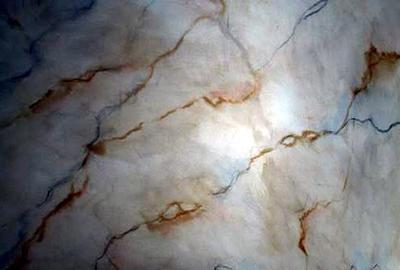Finding a different finish for home decorating projects can be time-consuming and expensive. It’s not surprising that many homeowners decide to go with wallpaper or basic finishes for painting. Fortunately, there’s a finish option that can be learned easily and doesn’t require expensive tools or supplies. This option is a faux marble finish.
One of the great advantages to learning how to create faux marble finishes is that once learned, this skill can be used to give a marble-like appearance to any surface in the house – walls, counter tops or even furniture.
Here are some basic steps to creating a faux marble finish.
First, gather your tools. To create a pale marbling effect (which is a good way for a beginner to start), you’ll need the following:
- Eggshell paint for walls or undercoat for metal or wood for a background;
- Artists’ oil paints in various shades of gray, plus the color amber, to create the veins usually seen in marble;
- A translucent glaze to give a natural-looking sheen to the finish;
- Several kinds of brushes, including household paint brushes, a soft flat artist’s brush, a soft makeup brush, a natural sponge, and some lint-free rags or cloths;
- Glass paper and white spirit, a colorless organic liquid solvent distilled from petroleum and used primarily as paint thinner.
Start the process by mixing paint. A marble effect results from applying several layers of tinted glaze, mottling and veins over a white or pale-colored base-coat. You then dab on oil paint or eggshell paint that’s been tinted to give gradual variations of tone to the background color. The brushes and natural sponge are used to texturize the base-coat color.
To create an opaque glaze good for walls or counter tops, combine 3 parts oil-based scumble (a type of opaque glaze) with 5 parts white eggshell and 2 parts white spirit. Mix paint and glaze first, then add white spirit until the mixture is creamy. For a more translucent glaze, tint the paint-and-glaze mixture with stain such as the artists’ umber or other oil paint and then add an equal amount of white spirit.
Follow this sequence of steps in the process:
Rub the surface to be painted carefully to remove splinters on wood or counter tops and any paint flakes on walls. Apply undercoat or eggshell paint in a suitable color. Take extra care with this foundation step and the marble effect will look better when finished.
If necessary, apply a second coat of the base. Tint this coat slightly with gray oil paint and use the natural sponge to create some mottled areas.
Use an artist’s flat brush and artists’ oil paint to apply a random network of diagonal veins across the base surface. With a pale base coat, apply dark gray and burnt sierra. If creating a black marble effect, apply white and green for the veins.
Apply dark colors to strengthen some of the veins. Then soften the appearance by brushing over the surface with a dry soft brush or a soft feather. Then create variations in tone using a natural sponge to lift off color or apply more paint there it’s needed.
Finally, finish off the faux marble effect with a translucent glaze tinted with light umber. Choose a few patches to give an extra coat of glaze for a natural weathered appearance. Protect the special finish by applying first a coat of clear gloss varnish, and then a coat of satin varnish. These final two layers will add more depth and sheen to the effect, making it look even more like genuine marble.
Since the materials for this technique are so inexpensive, you can experience with different shades and try bringing out more of the veins. With patience and practice, you should have some impressive results.


